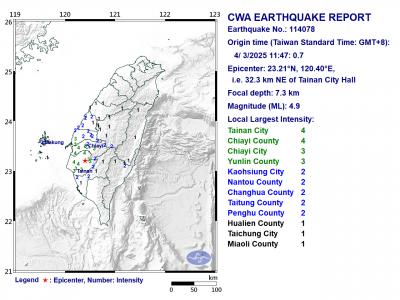The Hualien County Environmental Protection Bureau yesterday sampled wastewater from an outflow pipe at Chung Hwa Pulp Corp’s Hualien paper mill, after receiving complaints from residents that the facility discharged substandard wastewater into the Hualien River (花蓮溪), turning it into a tawny color.
Bureau officials took four samples which are to be tested for apparent color, suspended solids concentration, chemical oxygen demand and conductivity by laboratories certified by the Environmental Protection Administration (EPA). The results are expected to be released in two weeks.
Aside from the turbid outflow, residents also cited a “rancid” smell, allegedly coming from the facility’s chimneys.
Chung Hwa Pulp senior specialist Yen Shih-hsiung (顏世雄) said the brownish-yellow substance that colored the river is lignin, a product dissolved from wood chips when making pulp.
He said that although wastewater from the facility is properly processed and bleached before it is discharged, it is impossible to remove lignin completely.
He denied allegations that the plant dumped substandard wastewater over the holiday period, saying that the site’s outflow is properly treated and bleached, with monitoring data to prove it.
Bureau Director-General Jao Chung (饒忠) said that residents had often complained that the firm had dumped illegal discharge during holidays or early morning to avoid scrutiny.
However, since a wastewater monitoring system was installed by the paper mill in December last year, the bureau has not found any abnormalities in the facility’s effluent, he said.
Measurements taken at the outflow pipe, updated every two hours, found the quality of the plant’s effluent to be normal over the holiday period, and results of relative accuracy test audits — which Chung Hwa Pulp administered on an EPA order, to control measurement accuracy within an acceptable margin of error — have indicated that all of the plant’s discharge conforms to EPA standards, Jao said.
He said that rivers across the nation are in their low-flow period, which might have caused wastewater discharge from the plant to look darker, as there is less water in the river to dilute it.
Under the Water Pollution Control Act (水汙染防治法), the apparent color of industrial wastewater cannot exceed 550, based on an index. The outflow from the facility ranges between 350 and 450, Jao said.
On the alleged air pollution caused by the facility, he said that the bureau has been in talks with the company over installing an emissions monitoring system inside its chimneys.

‘DENIAL DEFENSE’: The US would increase its military presence with uncrewed ships, and submarines, while boosting defense in the Indo-Pacific, a Pete Hegseth memo said The US is reorienting its military strategy to focus primarily on deterring a potential Chinese invasion of Taiwan, a memo signed by US Secretary of Defense Pete Hegseth showed. The memo also called on Taiwan to increase its defense spending. The document, known as the “Interim National Defense Strategic Guidance,” was distributed this month and detailed the national defense plans of US President Donald Trump’s administration, an article in the Washington Post said on Saturday. It outlines how the US can prepare for a potential war with China and defend itself from threats in the “near abroad,” including Greenland and the Panama

A magnitude 4.9 earthquake struck off Tainan at 11:47am today, the Central Weather Administration (CWA) said. The hypocenter was 32.3km northeast of Tainan City Hall at a depth of 7.3km, CWA data showed. The intensity of the quake, which gauges the actual effect of a seismic event, measured 4 in Tainan and Chiayi County on Taiwan's seven-tier intensity scale, the data showed. The quake had an intensity of 3 in Chiayi City and County, and Yunlin County, while it was measured as 2 in Kaohsiung, Nantou County, Changhua County, Taitung County and offshore Penghu County, the data showed. There were no immediate reports of

The Chinese Nationalist Party (KMT) is maintaining close ties with Beijing, the Democratic Progressive Party (DPP) said yesterday, hours after a new round of Chinese military drills in the Taiwan Strait began. Political parties in a democracy have a responsibility to be loyal to the nation and defend its sovereignty, DPP spokesman Justin Wu (吳崢) told a news conference in Taipei. His comments came hours after Beijing announced via Chinese state media that the Chinese People’s Liberation Army’s Eastern Theater Command was holding large-scale drills simulating a multi-pronged attack on Taiwan. Contrary to the KMT’s claims that it is staunchly anti-communist, KMT Deputy

RESPONSE: The government would investigate incidents of Taiwanese entertainers in China promoting CCP propaganda online in contravention of the law, the source said Taiwanese entertainers living in China who are found to have contravened cross-strait regulations or collaborated with the Chinese Communist Party (CCP) could be subject to fines, a source said on Sunday. Several Taiwanese entertainers have posted on the social media platform Sina Weibo saying that Taiwan “must be returned” to China, and sharing news articles from Chinese state media. In response, the Mainland Affairs Council (MAC) has asked the Ministry of Culture to investigate whether the entertainers had contravened any laws, and asked for them to be questioned upon their return to Taiwan, an official familiar with the matter said. To curb repeated